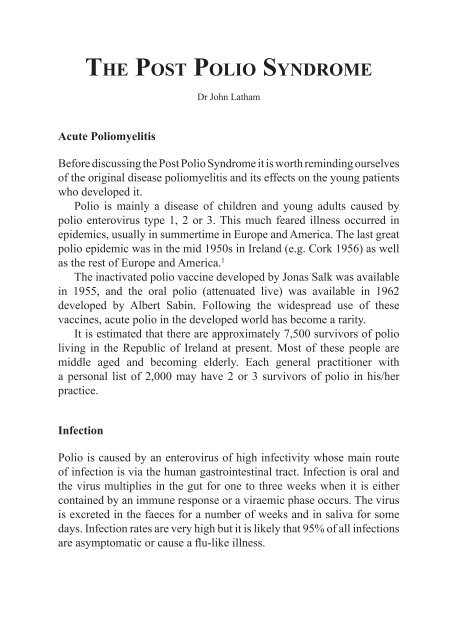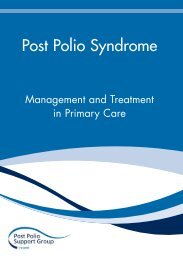Post Polio Syndrome - Management & Treatment in Primary
Post Polio Syndrome - Management & Treatment in Primary
Post Polio Syndrome - Management & Treatment in Primary
You also want an ePaper? Increase the reach of your titles
YUMPU automatically turns print PDFs into web optimized ePapers that Google loves.
the <strong>Post</strong> <strong>Polio</strong> syndrome<br />
Acute <strong>Polio</strong>myelitis<br />
Dr John Latham<br />
Before discuss<strong>in</strong>g the <strong>Post</strong> <strong>Polio</strong> <strong>Syndrome</strong> it is worth rem<strong>in</strong>d<strong>in</strong>g ourselves<br />
of the orig<strong>in</strong>al disease poliomyelitis and its effects on the young patients<br />
who developed it.<br />
<strong>Polio</strong> is ma<strong>in</strong>ly a disease of children and young adults caused by<br />
polio enterovirus type 1, 2 or 3. This much feared illness occurred <strong>in</strong><br />
epidemics, usually <strong>in</strong> summertime <strong>in</strong> Europe and America. The last great<br />
polio epidemic was <strong>in</strong> the mid 1950s <strong>in</strong> Ireland (e.g. Cork 1956) as well<br />
as the rest of Europe and America. 1<br />
The <strong>in</strong>activated polio vacc<strong>in</strong>e developed by Jonas Salk was available<br />
<strong>in</strong> 1955, and the oral polio (attenuated live) was available <strong>in</strong> 1962<br />
developed by Albert Sab<strong>in</strong>. Follow<strong>in</strong>g the widespread use of these<br />
vacc<strong>in</strong>es, acute polio <strong>in</strong> the developed world has become a rarity.<br />
It is estimated that there are approximately 7,500 survivors of polio<br />
liv<strong>in</strong>g <strong>in</strong> the Republic of Ireland at present. Most of these people are<br />
middle aged and becom<strong>in</strong>g elderly. Each general practitioner with<br />
a personal list of 2,000 may have 2 or 3 survivors of polio <strong>in</strong> his/her<br />
practice.<br />
Infection<br />
<strong>Polio</strong> is caused by an enterovirus of high <strong>in</strong>fectivity whose ma<strong>in</strong> route<br />
of <strong>in</strong>fection is via the human gastro<strong>in</strong>test<strong>in</strong>al tract. Infection is oral and<br />
the virus multiplies <strong>in</strong> the gut for one to three weeks when it is either<br />
conta<strong>in</strong>ed by an immune response or a viraemic phase occurs. The virus<br />
is excreted <strong>in</strong> the faeces for a number of weeks and <strong>in</strong> saliva for some<br />
days. Infection rates are very high but it is likely that 95% of all <strong>in</strong>fections<br />
are asymptomatic or cause a flu-like illness.<br />
PPS Mngt and Treat.<strong>in</strong>db 1 02/07/2007 16:07:48





